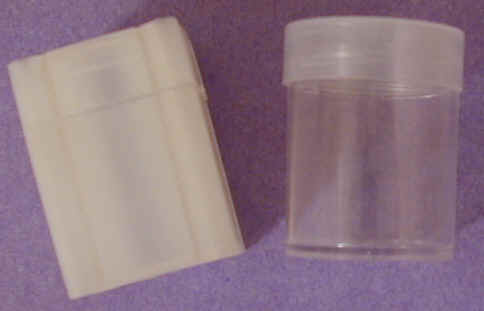Together, both movements have created a wide awareness of the BU roll market. However, from the questions we hear everyday, it is clear that few people really understand the processes through which BU rolls are handled as they flow from the Mint to the ultimate consumer or collector. Similarly, the queries we receive make it clear that the terminology used in the roll trade is often misunderstood and very frequently misused, even by experienced buyers and sellers. Through this article we hope to debunk some of the more common myths and provide a better understanding of the processes involved.
Part 1: History of Roll CollectingDavid Lange writes in the The Complete Guide to Lincoln Cents that collecting coins by the roll first became relatively common in the mid-1930s. Indeed, 1934 is the first year represented in the Coin Dealer Newsletter's price sheet for BU rolls which would seem to substantiate Lange's research. Our experience also correlates as we frequently buy and sell BU rolls from about the mid-1930s to date but rarely see earlier rolls. For a couple of decades, Lange writes, collectors and speculators generally confined themselves to a roll or two of each date. Then, in 1955, it was widespread knowledge that 1955 would be the last year for use of the S mintmark on the Lincoln Cent. Accordingly, collectors and speculators not only set aside more rolls than usual but even began to hoard and trade cents in bag (100 roll) lots.
In the years that followed, collecting current issues in roll and bag quantities became even more widespread reaching its height in the 1960s. In 1960, the mid-year revision of the cent dies creating a large and small date version heated up the speculation in current issues in roll and bag quantities. Then, starting in 1961, it became growingly apparent that the nation was in a coin shortage. While the shortage was actually due to an increased demand for coin and currency driven by a growing economy and the proliferation of vending machines, the Mint blamed collectors, speculators and hoarders for the shortage.
At the height of the shortage in 1964m the Mint began to take measures to reduce the amount of coins withdrawn from circulation in roll and bag quantities by collectors, hoarders and speculators. The first step was legislation in late 1964 that froze the 1964 date on coins until the shortage was remedied. Second, mintmarks were removed from coins for 1965 through 1967. In both instances, the thinking at the time by those in charge was that by reducing the number of different date/mintmark combinations that could be collected or hoarded, the aggregate amount of coins pulled out of circulation for such reasons would be reduced.
| 1962 | 1963 | 1964 | 1965 | ||
| Cents | 2402 | 2531 | 6452 | 1497 | |
| Nickels | 381 | 455 | 2816 | 136 | |
| Dimes | 410 | 548 | 2291 | 1652 | |
| Quarters | 167 | 213 | 1268 | 1820 | |
| Halves | 48 | 92 | 433 | 66 | |
| Table 1: Mintage figures (in millions) showing record 1964 mintages. | |||||
Accordingly, 1964-dated coinage was produced through all of 1964 and much of 1965 resulting in record mintages for the date (see Table 1). It was also the last year for 90% silver dimes, quarters and halves for circulation causing even more people to put away rolls of this already widely available date. As a result, even today, 1964-dated coinage is one of the most readily available in BU rolls, with the 1960 to 1963 coinage also being plentifully in BU roll quantities.
Speculation in any commodity tends to drive prices continually to new highs with everyone clamoring to buy and limited quantities available. Then, one day, large holders began selling and soon everyone is a seller, there are no buyers and the market crashes. The crash in the BU roll market came in late 1964 and for many dates the prices have not recovered to the 1964 high ever since.
Each passing year since 1964 up until 1999 has seen fewer and fewer BU rolls put away in the year of issuance. Just look at any price guide that includes pricing information for BU rolls and notice the general trend. The 1960s rolls tend to be a few cents over face value--virtually no premium despite being 40 years old and in BU quality. The rolls from the 1970s are bit more pricey but not as much so as those from the 1980s or early 1990s.
Uncirculated Sets (aka Mint Sets) sold annually by the US Mint represent the primarily source for BU singles during the post-roll-bust era. For the most part, a few million sets were produced each year and the packaging has kept the coins in nice BU condition and suitable for sales as singles. One notable exception is the years 1982 and 1983 when no Mint Sets were produced. As a result, prices for rolls from these two years are outliers. Take, for example, the 1983-P quarters. At this writing (April 2003) the wholesale dealer Ask price, as reported in the Coin Dealer Newsletter, is $800.00 per roll. Compare that to the comparable price for 1981-P and 1984-P rolls of $12.50 and $16.00 respectively and one can see the impact of Mint Sets on the BU roll market. More importantly, one can see that very few coins were being put away in roll and bag quantities by the early 1980s.
Another event in the early 1980s that forever impacted the BU roll market was the rise in value of silver and gold to levels not seen previously (or since). Silver approached $50 per ounce and, as a result, many of the the BU rolls that were put away two decades previously came out of old-time collections and hoards and found their way into the melting pot. This somewhat offset the glut of early 1960s rolls but even today they are still readily available.
The final two impacts on the BU roll market came in the mid to late 1990s. First, a significant subset of collectors began to pursue their favorite series in as nice of condition as possible. This created a new market in coins for the finest known or near finest known examples unlike any every seen before. As a result, entrepreneurial dealers and collectors began searching rolls for the top quality coins. As prices for the finest known coins rose, BU roll prices were pulled up as well, particularly for unopened and original rolls.
The last (but by no means least) impact came in 1999 when the US Mint introduced the fifty-state series of circulating quarters. This immensely popular program made coin collectors out of much of the nation's population and a popular way of collecting these exciting new coins was in BU rolls. The short 10-week production schedule and economic ups and downs created an number of issues that are rarer than others in BU rolls. For those in shorter supply, prices rose causing speculators to enter the market, which in turn tended to create surpluses of other issues.
Now, around 70 years after roll collecting first became popular, it is again a widespread phenomenon within the hobby. Both times, it was accompanied by a large influx of new collectors into the hobby. Many of these new collectors are not content to build roll sets of the 50 State Quarters but are also looking to collect the earlier issues.
We frequently get requests for "Mint rolls" or "Fed rolls" Actually, neither of these entities wrap coins today and one never has. "Bank wrapped" rolls are also commonly requested as well as bought and sold in today's roll market. However, few banks actually wrap coins these days and that has been the situation for decades. Part 2 seeks to explain away these common misconceptions and help the reader better understand the processes surrounding wrapping of current coinage.
Of course, the process all starts at the US Mint where coins are manufactured. Generally, speaking most of the nation's coinage is produced by the main US Mint facility in Philadelphia or the branch facility in Denver. The Mint also has facilities in San Francisco and West Point but most of the circulation coinage is produced at either the Philadelphia or Denver facilities.
Again, generally speaking coinage needs east of the Mississippi River are met through the Philadelphia facility with the Denver facility filling orders west of the Mississippi River. Thus, depending on where one lives, typically only P-mint or D-mint coinage can be obtained locally. There have been notable exceptions with new issues, shortages, surpluses and other anomalies but for the most part this rule has held true.
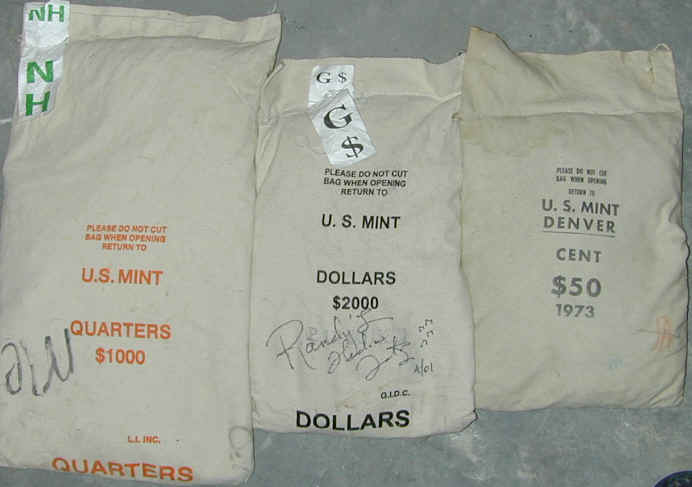 |
|
| Image 1: Mint-sewn bags of quarters, dollars and cents. | |
The Mint ships coin to regional Federal Reserve banks. The coins leaves the Mint and arrives at the Federal Reserve branch bank in bulk lots. Historically, coins were delivered in "mint-sewn bags" (see Image 1). Thes number of coins in these bags varied by denomination containing 5000 cents, 4000 nickels, 5000 dimes, 4000 quarters, 2000 half dollars or 2000 dollars. Roll collectors note that the coins left the Mint loose in bags, not rolled.
In late 2000 and early 2001, in a cost cutting move, the Mint discontinued use of the traditional sized bag and opted instead for a larger bulk, or "jumbo" bag, containing from 50 to 100 times the number of coins that were previously placed in the smaller bags. Specifically, these larger bags contained 400,000 cents, 240,000 nickels, 500,000 dimes, 200,000 quarters, 100,000 half dollars or 140,000 dollars (source Coin World). Note that even after the process change, coins still left the Mint facility in unrolled form.
The Federal Reserve Bank branches store coins in the bulk bags as received from the Mint until receiving an order from one of their customers, typically a commercial bank or other depository institution. Typically, the local banks contract with an armored car company (e.g., Brinks, Loomis, Wells Fargo, Dunbar, etc.) to pick up the coins from the Federal Reserve bank and deliver them to the local bank. However, the local banks desire the coin in rolled form for easy dispensation to their customers. As a result, the armored car companies have central processing facilities where they take the bagged coinage for wrapping into rolls and boxing prior to delivery to the requesting bank. Yes, it is the armored car companies that wrap the vast majority of coins into rolls in today's economy and has been for the last few decades.
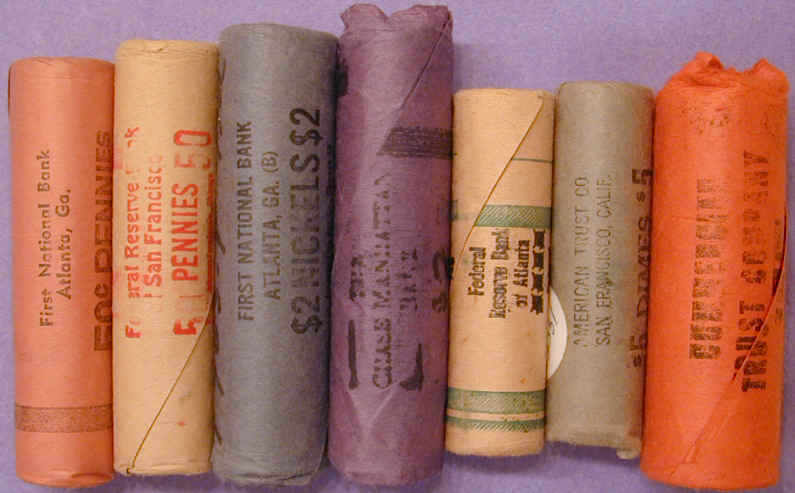 |
|
| Image 2: Rolls from the 1950s and 1960s with bank names. | |
Back in the days when there was one or two main banks in town, long before banks tried to have a branch in every neighborhood, larger banks often had their own wrapping machines. Their larger volume at a single location warranted the initial expense of a wrapping machine (which can cost as much as a small automobile) and the required regular maintenance program. Particularly large banks often ordered wrapping paper pre-printed with their bank name. These rolls, true "bank wrapped" rolls (see Image 2) are often seen on rolls from the 1940s, 1950s and 1960s but seem to have largely disappeared by the 1970s. During this same era, and particularly the 1950s, the Federal Reserve Banks also had wrapping machines and did wrap some of the coins, especially for smaller banks without wrapping equipment. Consequently, one can sometimes find rolls from this era stamped with the name of a Federal Reserve Bank.
However, as banking spread all over town, the economies of scale were lost and it became even more important to have a reliable vendor provide transportation of coin and currency between the Federal Reserve Bank and the many local bank branches. Since the Federal Reserve Bank did not wrap the coins and the individual local banks did not have wrapping equipment, the job of wrapping coins was left to the armored car companies. Did you ever wonder why banks required you to wrap coins before they will accept them for deposit? It is because they do not have a wrapping machine on premises and the do not have the staff to hand wrap large volumes of coins.
In summary, the vast majority
(probably well above 99%) of the rolls today are wrapped by the armored
car companies and the names "Mint wrapped", "Fed
wrapped" and even "bank wrapped" are all misnomers as
applied to modern coin rolls.
Image 3: Coin tubes.
There are a number of containers for holding a roll of coins. Coin tubes (see Image 3) made of sturdy plastic with either screw on or snap on caps are often used for more expensive rolls as they provide better protection. Due to the expense these are not used by banks but rather are exclusively collector-used products. Hence, they are an after-market addition to the roll.
Part 3B: Hand Wrapped Rolls
 |
 |
|
| Image 4: Flat coin wrappers (left) and preformed tubular coin wrappers (right). | ||
There are two basic types of paper rollers for hand wrapping rolls (see Image 4). The most common rollers for hand wrapping rolls come flat. They are opened to allow insertion of the coins and then closed by folding over the excess paper on each end of the roll. This is the least expensive type of paper wrappers and small quantities are frequently available to account holders at local banks at little or no cost. Larger quantities are readily available at most office supply stores.
The second most common type of paper wrap for hand wrapping rolls come preformed in a tube shape with one end machine crimped. Coins are inserted into the tube and the roll is sealed by folding the uncrimped end over the coins. These paper tubes are easier to use but more expensive and thus not usually provided free at banks. They too are available at most office supply stores.
Part 3C: Machine Wrapped RollsThe first type of machine wrapped roll we discuss also utilized preformed paper tubes like those discussed in the prior section. In this case, the machine is only used to seal the rolls. The coins are still inserted manually in the tube and then the machine is used to crimp the open end of the paper tube. Typically the non-factory end is not crimped as tightly. Also, the paper tends to be loose around the roll since the tube is slightly larger than the diameter of the coins so that the coins can be easily inserted without jamming. These crimping machines are very inexpensive (compared to a wrapping machine) since all they do is seal the tube. This type of crimping machine is available for a few hundred dollars for higher volume users. For smaller volume users and home use, hand versions and a supply of preformed tubes can be purchased for less than $10.
 |
| Image 5: High speed wrapping machine. |
The vast majority of rolls today are wrapped with a wrapping machine (see Image 5). These sophisticated machines--often costing as much as a small car--have larger hoppers capable of holding a few hundred rolls of coins at a time. The machines reject misshapen coins, coins of other denominations, off-center strikes, and the like. They count the correct number of coins into the roll for the chosen denomination, tightly wrap the roll and nicely crimp the ends. The entire process takes no more than a few seconds per roll.
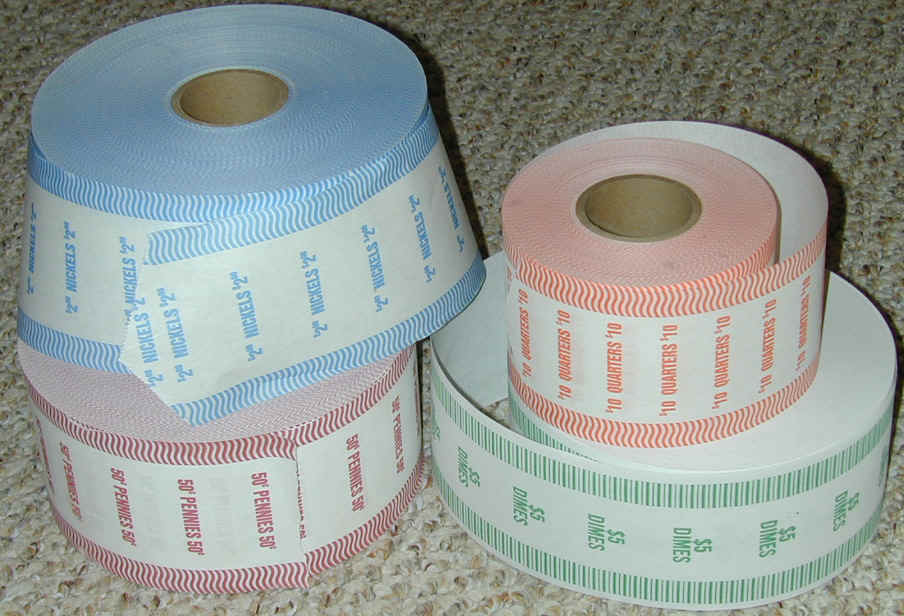 |
| Image 6: Rolls of wrapping paper. |
These high speed wrapping machines utilize wrapping paper that comes on a large roll, just like toilet paper, only in a even larger roll (see Image 6). Several companies manufacture paper for these machines. From the volume of rolls we have seen, N.F. String & Son appears to have the lion's share of the market. Partly, that might just be that N.F. String & Son appears to be the only manufacturer that actually puts its name on the roll. Many new roll collectors mistake the presence of the N.F. String & Son name on the wrapper to mean they were the company that wrapped the roll. About twice a month we receive a request for rolls "wrapped by N.F. String & Son" and have to explain that "they just print the paper." Visit the N.F. String & Son website to learn more about the company and see the coin and currency wrapping products they sell. Other vendors of rolls of wrapping machine paper include Clean Sweep Supply, US Bank Supply, and Keysan among many others.
| Denomination | Color | |
| Cents | Red | |
| Nickels | Blue | |
| Dimes | Green | |
| Quarters | Orange | |
| Halves | Yellow | |
| Dollars | Gray | |
| Table 2: ABA Standard Colors. | ||
The various suppliers of this paper generally have slightly different designs. However, all conform to American Banking Association standards on the colors used. Typically the paper is white (although occasionally kraft) with the color of the printing indicating the denomination (see Table 2). The printing will specify the dollar value of the roll and the denomination.
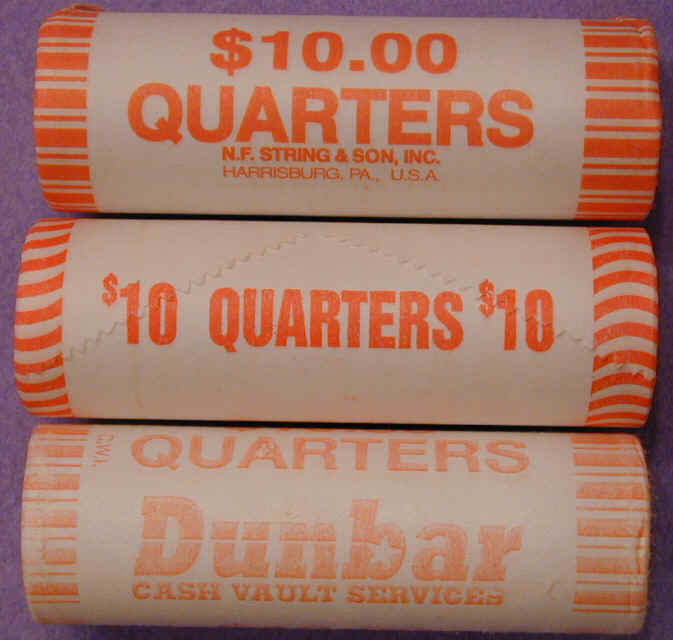 |
|
| Image 7: Various quarter wrapping paper styles. | |
Many of the manufacturers will also custom print the paper with the name of the armored car company. As a result, there are a variety of different looks within the same standards. Image 7 shows three variations : N.F. String & Son (top), generic (middle), and printed with armored car company name (bottom).
 |
|
| Image 8: "Shrink wrapped" rolls. | |
Beginning in the 1990s, a new type of machine was introduced that wrapped coins in a plastic sleeve, making them appear "shrink wrapped" (see Image 8). The plastic is tightly stretched over the roll of coins keeping them together. The coins are easily removed by squeezing the roll or tearing away the plastic wrapping.
The paper styles shown in Images 6 and 7 are examples of the types in use today. When one looks back at older rolls, the style was different. It seems the above-described styles (mostly white with color coded printing) came into being around around the mid-1970s. Prior to that and going back to the 1930s, most of rolls tend to have been wrapped in solid color paper (like those in Image 2 above). Typically, the paper itself is color coded to denomination with the printing typically being in red or black. The solid wrapper colors generally correlate to the color scales shown in Table 2 above. The cent and nickel are the main denomination seen with variations. While red wrappers are very frequently encountered on cent rolls of this era, and blue wrappers are typical on nickel rolls of the era purple wrappers are also common for both denominations. Sometimes, kraft colored paper can be found on all denominations from this era.
Part 3D: Rolls Sold by the US Mint.
Starting with the introduction of the Sacagawea Dollar in 2000, the US Mint has sold specially wrapped rolls of some denominations to collectors (see Image 10). Actually, the the first specially wrapped rolls of Sacagawea Dollars were distributed to Wal-Mart and other promotional partners as part of the introduction of the Sacagawea Dollar. Later that year, rolls wrapped in the same gold and black paper were sold to collectors. These specially wrapped rolls of Sacagawea Dollars have been offered each subsequent year as well.
Starting with the issuance of the New Hampshire quarter in late 2000, the US Mint began selling State Quarter rolls specially wrapped in a orange, black and white wrapper. These wrappers have the two letter postal code for the state as well as the P or D mintmark in large letters. These rolls have been offered for each subsequent state as well. However, none were issued for the 1999 states or the first three states in 2000.
In 2002, the US Mint sold Kennedy Half Dollars in blue and white wrapped rolls. The Mint has continued to offer these blue and white wrapped half dollar rolls each year since. In 2004, the Mint offered not only 2004-dated halves in these specially wrapped rolls but also released 2001-dated halves as well.
In 2003, the US Mint offered specially wrapped rolls of 2003 Jefferson Nickels. The special packaging of this denomination continued the following two years with the issuance of the commemorative reverse Westward Journey nickels and again in 2006 with the Return to Monticello Jefferson nickels.
While the US Mint sold these rolls directly to the public, they were not wrapped at the US Mint (remember, we said the Mint does not wrap rolls). Instead, they were shipped to an outside contractor in bulk bags for wrapping (source: Coin World and Coin World). Thus, the handling these coins received is essentially the same as those issued through the Federal Reserve for circulation. The coins were shipped off-site in bulk bags to a third-party contractor for wrapping. The contractor then dumped the coins in a wrapping machine hopper and wrapped them in the specially printed paper. Next, they were shipped to the Mint's order processing contractor in Memphis, Tennessee. There, they were stored until needed to fill customer orders when they were then shipped through the US Postal Service to the ultimate customer.
 |
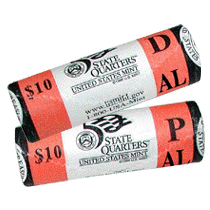 |
 |
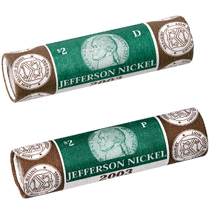 |
| Image 10: From left to right, BU rolls sold by the US Mint: Sacagawea Dollars, State Quarters, Kennedy Half Dollars and Jefferson Nickels. | |||
This section focuses on the issue of proper storage of BU rolls which generates a lot of questions among collectors. In short, there are a lot of acceptable options and a few wrong ones.
The main situation to avoid is storing rolls in a wet environment or one that is not climate controlled. Extra precaution should be taken in coastal areas due to the presence of salt in the air and general environment.
Many people choose to store their valuables, including rolls of coins in a home safe. Those with fire-rated safes should understand that these safes typically trap moisture (ask your safe's manufacturer for details if you have one of these safes). As a result, storing coins in these types of safes requires extra care in keeping silica crystals or another absorbing agent present and active in the safe to keep any trapped moisture away from the coins. This requires regularly replacing or renewing the absorbing agent.
Another common roll collector dilemma is whether to keep the rolls in the original wrapper or open them and place the coins in a plastic tube. As one would expect, there are advantages and disadvantages to both. On the one hand, a sealed tube better protects the coins from moisture and environmental contaminants. Sulfur, widely present in the environment and a component of most wood and paper products (including the paper used to wrap coin rolls), causes coins to tone (turn dark). This is particularly true of silver and copper coins which are very reactive. The toning concern is less acute with nickel and copper nickel clad coins. Keeping coins in their original color is usually best accomplished long-term through the use of tubes for roll storage.
On the other hand, coins can be fingerprinted or otherwise impaired in the process of transferring them from a roll to a tube if one is not extremely careful. Also, coins are typically a little loose within coin tubes which could allow them to rub together and lessen the quality of the coins. Finally, today's current BU roll market places a premium on unopened rolls. This has not always been the case and likely will not always be the case. Notwithstanding, the disparity in price on some issues today is great enough to warrant consideration of this factor in the tube/paper decision.
Part 5: GlossaryWe have attempted to include the more common terms used in the BU roll trade and give their technical meaning as well as meaning in conventional use, if different.
Bank Wrapped--1. A roll wrapped by a bank. Rolls were commonly wrapped by banks in the 1950s and 1960s. Typically the "bank wrapped" status is evidenced by the presence of a bank name printed on the wrapping paper itself. While technically the term could apply to rolls hand wrapped by banking personnel, the term typically is applied only to machine wrapped rolls. 2. Often, the term is more broadly used to refer to an unopened, machine wrapped roll whether wrapped by a bank or not, especially when applied to rolls from the 1970s and later (which were rarely wrapped by banks (typically the wrapping was done by armored car companies)).
BU Roll--A brilliant uncirculated roll. The roll may be original and/or unopened but neither is required to be a BU roll.
Crimped End--The tightly, rolled up end of a machine wrapped roll.
Fed (or Federal) Wrapped--1. Technically, a roll wrapped by a Federal Reserve Bank branch. Rolls were commonly wrapped by Federal Reserve Banks branches in the 1950s and 1960s. Typically the Federal Reserve status is evidenced by the presence of a Federal Reserve Bank branch name printed on the wrapping paper itself. 2. Often more broadly and erroneously used to describe a roll as being wrapped by a Federal Reserve Bank that was not actually by a Federal Reserve Bank when in actuality the Federal Reserve no longer wraps rolls. Instead, the rolls this term is used to describe in conventional use are rolls that were wrapped by an armored car company delivering bulk coinage from the a Federal Reserve Bank branch to a local branch bank. They are wrapped in paper that has been standardized by the American Banking Association. This "official look" cause many (if not most) people to assume they are government wrapped.
FMS--An acronym for "from Mint Sets" used to describe a roll that was put together by cutting coins from Mint Sets.
Folded End--The folded over end of a hand wrapped roll.
H/T or Heads/Tails--Typically used to describe a State Quarter roll that has the heads side of a coin (with the mintmark) showing on one end and the tails side of a coin (with the state design) showing on the other. This enables one to identify the state and mintmark without having to open the roll.
Mint (Wrapped) Roll--1. Often erroneously used to describe a roll as being wrapped by the Mint when in actuality the Mint does not wrap rolls. Instead, these rolls are typically rolls that were wrapped by an armored car company delivering bulk coinage from the a Federal Reserve Bank branch to a local branch bank. 2. Rolls of Sacagawea Dollars, State Quarters or Kennedy Half Dollars sold by the US Mint (but wrapped by an outside contractor) in specially designed, colorful paper. 3. A BU roll (the term "mint" is often used as a synonym for "uncirculated" as in "mint state.")
N.F. String & Sons--A company that manufactures coin and currency wrapping products, including rolls of wrapping paper used in wrapping machines. N.F. String & Sons is one of the most widely used brands of paper and one of the few manufacturers that prints its name on the paper, causing some collectors to believe (erroneously) that the rolls were actually wrapped by N.F. String & Sons.
OBW or Original Bank Wrapped--Technically an original, bank wrapped (i.e., has the bank name preprinted on the wrapping paper) roll. More often used to describe any unopened, machine-wrapped roll.
Original--A term used to describe a roll that has remained intact since the year of issue. A roll that has had a coin or coins removed and replaced is not original. The term is often used to describe an unopened roll, however, rolls can be opened (even tubed) and still be original.
O/W or Orange/White--A term used on quarter rolls to describe the type of wrapping paper (white with orange printing) used to wrap the roll.
Put-Together Roll--The opposite of an original roll; a roll that has been made by combining coins from two or more rolls, often after cherry picking the varieties and/or high grade coins from the roll.
Shotgun Roll--1. Originally, a term was used to describe a roll that was twice the typical length (as in a double barrel shotgun). For example, casinos frequently wrap half dollars in $20 (40-coin) rolls. 2. Some also apply the term to describe a hand wrapped roll that was wrapped utilizing a preformed tube. The preformed end is rolled up and crimped like the end of a shotgun shell, while the other end is folded over. 3. Most often today used to describe any machine wrapped, paper roll.
Shrink Wrapped--Rolls that have been wrapped in a stretchy, plastic sleeve rather than a paper wrapper.
Tubed--A roll that has been removed from its paper wrapper and placed in a plastic tube.
Unopened--A roll that has not been opened.
Unsearched--A roll that has not been searched for errors, varieties, higher grades or other more desirable coins. Typically used to describe an unopened roll but even opened rolls can be unsearched.
